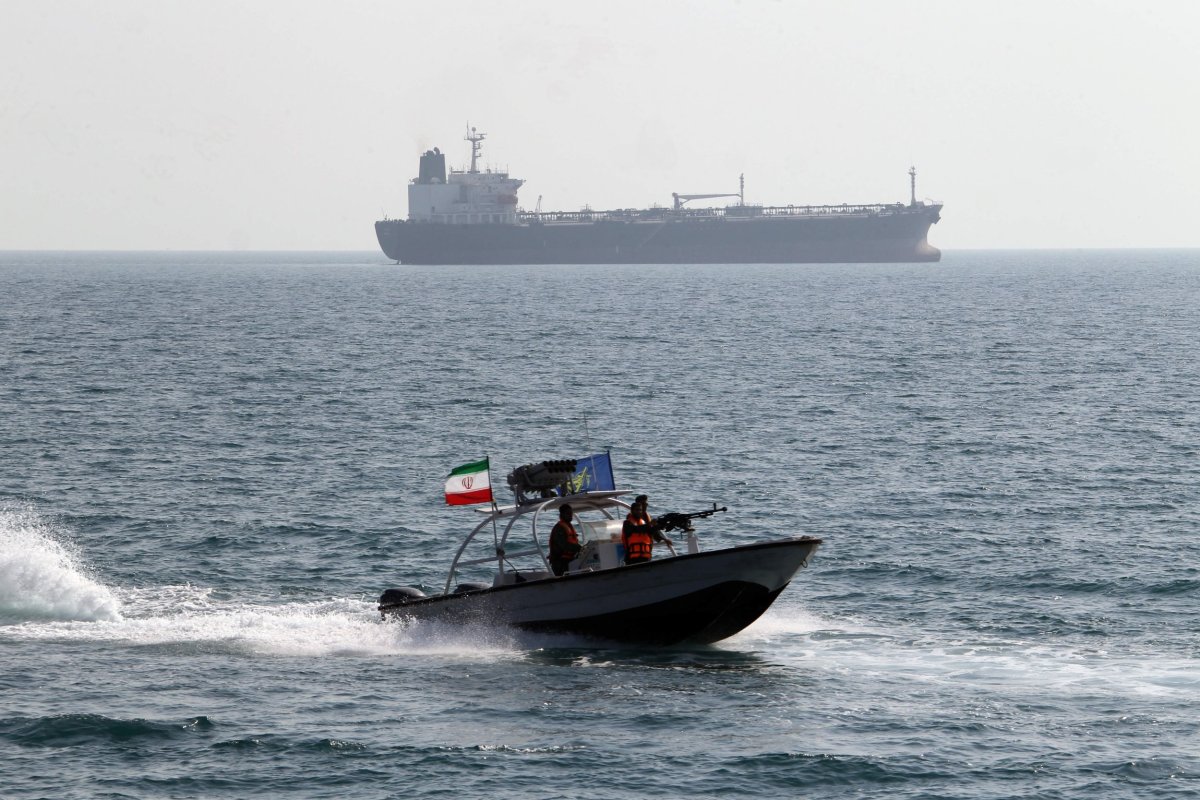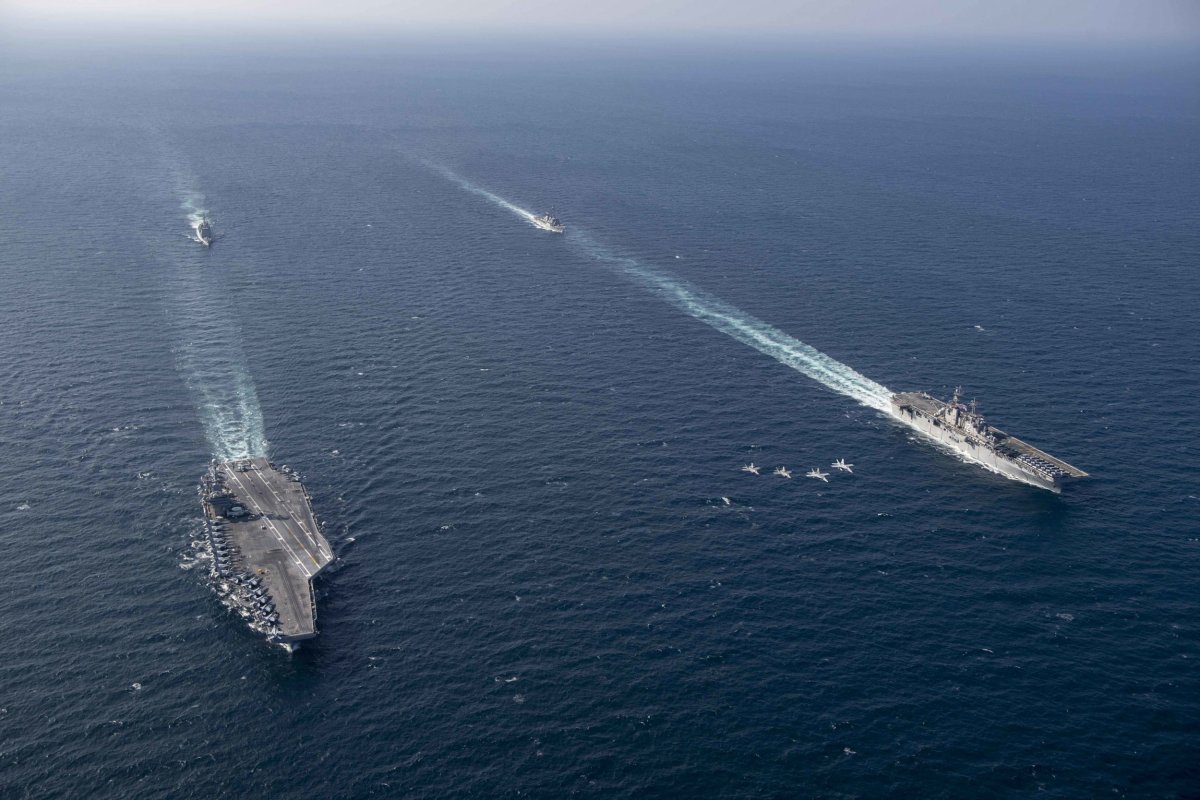The Iranian military was set to hold massive war games across the country's south just as the first U.S. aircraft carrier entered the nearby waters of the Persian Gulf, breaking a months-long absence.
Brigadier General Mohammad Pakpour, commander of Iran's elite Revolutionary Guards ground force, told reporters Friday that the final stage of the Payambar-e Azam, or "Great Prophet," 12 drills would begin Saturday and include "rapid reaction units, airborne units, demolition and combat units, mid-range missiles and the third marine division." The military leader argued that the maneuvers were purely defensive, but warned that the country would not hesitate to strike back.
"We pose no threat to any country but if the enemies seek to implement their malicious intentions and attack us we will be absolutely aggressive and attack the enemies with all might and we are practicing these tactics in these exercises," Pakpour said, according to the semi-official Mehr News Agency.
The drills were set to take place on Qeshm Island, located just off the coast of Iran's southern Hormozgan province and in the Strait of Hormuz, where roughly one-third of the world's oil passes through. As tensions between the U.S. and Iran once again peak, officials in Tehran have threatened to close the world's most important energy chokepoint.

It was upon this backdrop that Nimitz-class nuclear-powered supercarrier USS John C. Stennis and its strike group entered the Persian Gulf that same day, breaking the longest U.S. carrier absence in the region since at least 9/11, the Associated Press reported. Some 30 Revolutionary Guards vessels reportedly followed the carrier and its accompanying warships, at one point launching rockets nearby. A commercial-grade drone was also said to have flown by, and one Iranian ship could be seen with photographers and journalists observing the aircraft carrier.
"The Iranian craft drove in front of our ship and stopped and tried to capture their own sort of picture of what was going on," said Navy Captain Randy Peck, commanding officer of the USS John C. Stennis, told the AP.
Despite their history of tense encounters, the U.S. has not recorded any incidents regarding Iranian ships in the Persian Gulf since August 2017, when an Iranian QOM-1 drone allegedly interrupted a U.S. Navy F/A-18 attempting to land on the USS Nimitz supercarrier. The event followed a series of maritime incidents between the longtime hostile nations, sometimes involving lasers and heavy machine gun fire.
The U.S. and Iran have been at odds since the 1979 Islamic Revolution that toppled a West-backed absolute monarchy reinstalled by the CIA after a popular uprising in the 1950s, and an ensuing hostage crisis. The revolutionary Shiite Muslim leadership that took power has been accused by the U.S. of funding militant groups abroad and seeking nuclear weapons, leading to international sanctions that were eventually lifted in a 2015 landmark agreement signed by the two nations, as well as China, France, Germany, Russia and the United Kingdom.
The deal, by which Iran agreed to curb nuclear production in exchange for sanctions relief, was opposed by President Donald Trump, who officially withdrew the U.S. from the pact in May. Since then, the Trump administration has reimposed sanctions, even as European allies sought to circumvent them in support of maintaining the nuclear accord.

In addition to its sizeable military, which includes both the Revolutionary Guards and conventional armed forces, Iran also commands the largest ballistic missile force in the Middle East. Iranian supreme leader Ayatollah Ali Khamenei said in February that the country would continue to develop its defense capabilities in the face of threats posed by the U.S. and its top regional allies Israel and Saudi Arabia.
Iran has also maintained close ties to regional, mostly Shiite Muslim movements battling supporting the governments of Iraq and Syria against mostly Sunni Islamist insurgencies. Arguably the most powerful of these groups is the Lebanese Hezbollah, which commands a sizeable rocket force of its own and is considered by Israel to be a major national security concern. Nevertheless, Iran denies having direct connections to the Zaidi Shiite Muslim group known as Ansar Allah or the Houthis battling a U.S.-backed, Saudi-led coalition in Yemen.
Both the U.S. and Iran have accused one another of destabilizing the region. On Wednesday, Secretary of State Mike Pompeo defended Trump's decision to pull U.S. troops fighting the Islamic State militant group (ISIS) in Syria, where Iran and Russia were assisting a separate, pro-Syrian government campaign against the jihadis.
"We've watched Iran be the world's largest state sponsor of terror from that region, and this administration has begun a massive campaign to put pressure on the Islamic Republic of Iran to stop that terror," Pompeo told the KFRM radio station. "We've done so by building out coalitions with our partners in the Emirates, Saudi Arabia, Bahrain, all around the Middle East, our Israeli partners, to do just that – to create stability in the Middle East and prevent terror attacks on our homeland."
Uncommon Knowledge
Newsweek is committed to challenging conventional wisdom and finding connections in the search for common ground.
Newsweek is committed to challenging conventional wisdom and finding connections in the search for common ground.
About the writer
Based in his hometown of Staten Island, New York City, Tom O'Connor is an award-winning Senior Writer of Foreign Policy ... Read more
To read how Newsweek uses AI as a newsroom tool, Click here.








